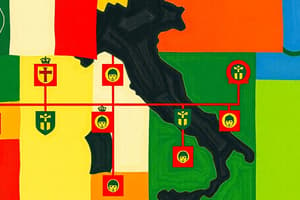Podcast
Questions and Answers
Define labor organization.
Define labor organization.
A labor organization (or labor union) is an association of employees created for the purpose of collective bargaining or dealing with employers concerning terms and conditions of employment.
What are the kinds of labor organization? (Select all that apply)
What are the kinds of labor organization? (Select all that apply)
- National Union or Federation (correct)
- Craft Union (correct)
- Company-Type Union (correct)
- Local Chapter or Chartered Local (correct)
- Industrial Union (correct)
- Company Union (correct)
- Trade Union Center (correct)
- Independent Union (correct)
- Affiliate (correct)
- Local Union (correct)
What is the distinction between labor organization and workers' association?
What is the distinction between labor organization and workers' association?
A labor organization is intended for collective bargaining purposes, while a workers' association is intended for mutual aid and protection of its members.
Who are qualified to form or join a labor organization?
Who are qualified to form or join a labor organization?
What is the point to consider in determining whether an employee holds a supervisory position?
What is the point to consider in determining whether an employee holds a supervisory position?
Supervisory employees and rank-and-file employees can lump into a single union.
Supervisory employees and rank-and-file employees can lump into a single union.
Can supervisory employees join the collective bargaining unit of rank-and-file employees?
Can supervisory employees join the collective bargaining unit of rank-and-file employees?
Flashcards are hidden until you start studying
Study Notes
Labor Organization Definitions
- A labor organization (or labor union) is an association of employees created for the purpose of collective bargaining or dealing with employers concerning employment terms.
- There are various types of labor organizations, including local, national, independent, and affiliate unions, as well as industrial, craft, and company-type unions.
- Company unions, formed with assistance from employers engaging in unfair labor practices, are specifically prohibited.
- A trade union center is an organization of registered national unions or federations that provides mutual aid, assistance in collective bargaining and social/employment policy.
Distinguishing Labor Organizations from Workers' Associations
- Labor organizations focus on collective bargaining, while workers' associations aim for mutual aid and protection.
- Workers' associations can include any type of employee in any establishment, while labor organizations are more restricted.
Who Can Form or Join a Labor Organization?
- The right to form, join, or assist in the formation of a labor organization is limited to:
- Rank-and-file employees: employees in positions without managerial oversight.
- Supervisory employees: employees with the power to effectively recommend managerial actions, including discipline or personnel movement.
- Supervisory employees are excluded if their power is routine or clerical in nature.
Supervisory employees and Rank-and-File Employees in Labor Unions
- Supervisory employees and rank-and-file employees cannot form or join the same labor union, as their interests often conflict.
- Supervisory employees must form their own separate labor organizations.
- The law explicitly prohibits supervisory employees from joining a rank-and-file collective bargaining unit.
- Their distinct interests are evident in areas like collective bargaining where supervisors may act against the interests of rank-and-file workers.
Studying That Suits You
Use AI to generate personalized quizzes and flashcards to suit your learning preferences.




